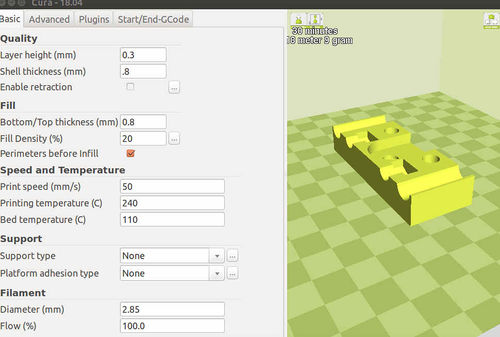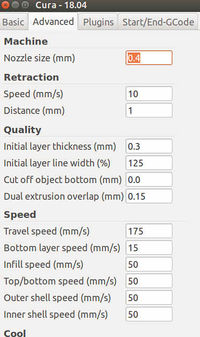Cura Settings: Difference between revisions
Jump to navigation
Jump to search
No edit summary |
|||
| Line 4: | Line 4: | ||
#Nozzle size - 1.2 mm | #Nozzle size - 1.2 mm | ||
#Layer height - 0.4 mm | #Layer height - 0.4 mm | ||
#Filament diameter - 2.85 | |||
#Sink object - 5 mm for 3D printed corners | |||
#Brim - typically no brim unless only a small portion of the printed object is touching. Brim lines recommended are typically 5-10 | #Brim - typically no brim unless only a small portion of the printed object is touching. Brim lines recommended are typically 5-10 | ||
#Raft - never | #Raft - never | ||
| Line 9: | Line 11: | ||
#Line width - even though the nozzle is 1.2 - we can print 1.0 line widths, and even 0.8 mm if necessary for smaller features such as holes near the edge on the extruder. | #Line width - even though the nozzle is 1.2 - we can print 1.0 line widths, and even 0.8 mm if necessary for smaller features such as holes near the edge on the extruder. | ||
# | # | ||
=Object Design Notes= | |||
#When designing objects with large flat bottoms, put a chamfer on the bottom so that you can get a tool under the chamfer to pry the object off the print bed. | |||
=.4 mm Nozzle on Lulzbot Mini= | =.4 mm Nozzle on Lulzbot Mini= | ||
Revision as of 16:43, 16 January 2021
D3D Cura Settings
The industry standard settings for the D3D printer for production printing at OSE are:
- Nozzle size - 1.2 mm
- Layer height - 0.4 mm
- Filament diameter - 2.85
- Sink object - 5 mm for 3D printed corners
- Brim - typically no brim unless only a small portion of the printed object is touching. Brim lines recommended are typically 5-10
- Raft - never
- Spiralize Outer Contour - for single-line prints
- Line width - even though the nozzle is 1.2 - we can print 1.0 line widths, and even 0.8 mm if necessary for smaller features such as holes near the edge on the extruder.
Object Design Notes
- When designing objects with large flat bottoms, put a chamfer on the bottom so that you can get a tool under the chamfer to pry the object off the print bed.
.4 mm Nozzle on Lulzbot Mini
This is what I did for 0.4 mm nozzle, as opposed to 0.5 standard. I reduced the values until the yellow highlight disappeared, assuming that the yellow highlight is no go. Result was stringy, so I left the settings at the 0.5 settings when using the 0.4 nozzle, and it worked much better.

